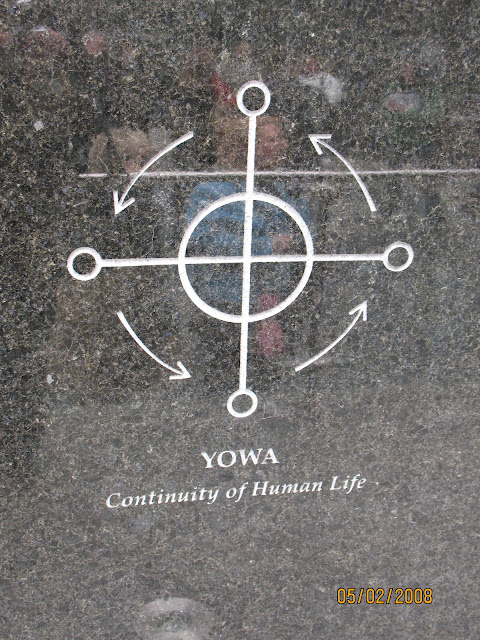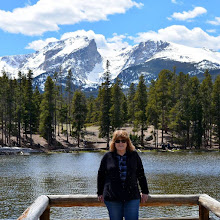
From the 1690s until the 1790s, both free and enslaved Africans were buried in a 6.6-acre burial ground in Lower Manhattan, outside the boundaries of the settlement of New Amsterdam, later known as New York. Lost to history due to landfill and development, the grounds were rediscovered in 1991 as a consequence of the planned construction of a Federal office building.
As construction for the federal building dug deep, the graves of hundreds of African men, women, and children, both enslaved and free, were uncovered. Most were found more than 20 feet below street level.
As construction for the federal building dug deep, the graves of hundreds of African men, women, and children, both enslaved and free, were uncovered. Most were found more than 20 feet below street level.
Here is a close-up photo of the writing on the "Wall of Remembrance":

Free and enslaved colonial Africans and African-Americans buried their dead here, on the edge of the growing city, as early as 1712, after many of New York’s churches denied their interment. Burials continued until about 1795 when the demands of a developing city and growing population encroached upon the cemetery. By 1812, many of the graves were covered with up to 20 -25 feet of fill dirt. Markings on a few historic maps became the only clue of its existence
The entire African Burial Ground is said to contain some 20,000 skeletal remains of New York City's first African-Americans.
The entire African Burial Ground is said to contain some 20,000 skeletal remains of New York City's first African-Americans.
In 1992, Congress appointed a federal steering committee to fund a project to study, memorialize, and publicize the African Burial Ground. In D.C., Howard University's bioanthropologist, Dr. Michael Blakey, was appointed the scientific director of the research branch of the project. During his 10 years of work at the burial ground, Blakey coordinated research of the site and its remains among teams of physical archaeologists, historians, anthropologists and others. The archaeological and historical contexts of the remains were analyzed by Howard University research teams and the Institute for Historical Biology at William and Mary.
Below is the entrance through the wall, called "The Door of Return."

"Though the identities of those buried remain unknown, analysis revealed that most excavated individuals had been placed in wooden coffins and buried facing east. Most were wrapped in white shrouds fastened with copper pins, and some were buried with objects, including coins, shells, glass, buttons, beads, clay pipes, coral, and quartz crystal. Approximately 45% of the burials were of children under age 12. Many individuals were malnourished, and some suffered from severe arthritis, muscle tears, and bone fractures caused by intense physical labor."
In 2003, the remains found at the site were reburied in Manhattan following ceremonies in five East Coast cities.
Around the circular floor are descriptions of the remains that were found:

Designed by architect Rodney Léon, the soaring, circular memorial is home to a wall of remembrance, ancestral pillars, a spiral processional ramp, and a "Circle of the Diaspora," which features symbols and images of African, Latin American, and Caribbean cultures. The U.S. General Services Administration funded the memorial, which was built and maintained in collaboration with the National Parks Service.
“My design tells the story and speaks to the greatness of a people who never ceased to push for freedom,” said Rodney Léon. “Their story began in Africa, and the origin of my design was born there too. By traveling to Africa and incorporating the shapes and forms, as well as the essence of the culture and people, I have created a living memorial to the ancestors and their stories.”
Source

In the photo below you can see our tour guide, dressed in a green jacket, describing the details of the monument to our tour group. Note the walls on the circular pathway in the photo and also the one above. Signs, symbols, and images of the African Diaspora are engraved around the perimeter.

The following photos are close-ups of some of the symbols.






The site was declared a National Monument on February 27, 2006, and it honors the culture and memory of the Africans and African-Americans who contributed to the building of our nation.
























13 comments:
Hi Pat! Wow, what an amazing place! I would imagine it would be a very emotional place to visit. Very moving.
I thought of you last night when Bo was on American Idol! I liked the song he did! I'm sure it wasn't as much fun as seeing him live and up close though!
Amazing! You should charge a course fee, dear one!
I have to give Hubby your blog link. He would most certainly enjoy your posts as much as I do!
:-) Rosie
What a beautiful post! I'm sorry to say I've never heard of it before. I'm so happy to know it exists. Thanks again Pat.
Pat, that is so fascinating, I have never heard of this before!
I did not know about this memorial but am so glad to learn that there is one. It makes me sad to think of lives lived and then lost to obscurity, but this memorial helps. I wonder if there are other such burial sites elsewhere that have been overlooked.
Thank you for sharing this.
Hi! Thanks so much for stopping by my blog. :o) It gave me the chance to find you, and what a great blog you have--so rich in variety! This was a fascinating post. That Wall of Remebrance is especially haunting and emotive. I did not know about it either. Thank you for sharing about this important site. You have so much here--I look forward to visiting again! Happy weekend :o)
Hi Pat! Just popping in to wish you a very happy Mother's Day weekend!
Nice post ~ very interesting and informative. I always learn something new when I come over here to visit. :)
Hi Pat,
What a beautiful monument! It looks like the center is convex? How sad for so many people to be buried in one location and forgotten for so long. What's even more sad is that the church didn't recognize them as human.
I'm still reading your post on the five points neighborhoods.
Elmo is doing fine. I work for an Indian woman who was a surgeoun (I can't spell, sorry) in India turned mid-wife in America. I took Elmo in to see her and she's given me instructions on what to do for him. My hubby says were practicing Indian Voodoo on poor little Elmo but, he seems to be healing up just fine. No infection or anything. Was that more information then you needed? If so...sorry!
Anyway, I'm off to finish your post on the five points. I really like the names of some of those gangs. Very creative, don't you think?
Another very intriguing post, Pat. So many things to see in New York. I could stay for a few weeks and still not see everything. :)
Just incredible! It is wonderful to know that the remains have been treated with the honor that they deserve. It is interesting to read what was discovered. Thank you again for another wonderful post.
Hi Pat :)
What an amazing place. I can't believe that it took that long for it to be found again.
off to read more...
rue
Gosh, 45% were children under 12...how sad.
Post a Comment